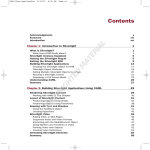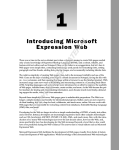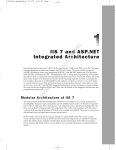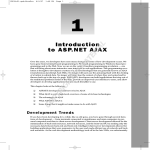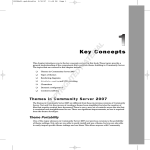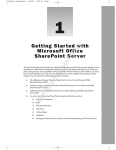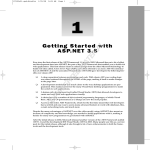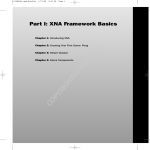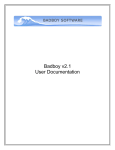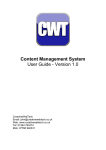Download Wiley Professional Joomla!
Transcript
8/25/07 1:18 PM Page 1 AL 33941c01.qxd:WroxPro TE RI Introducing Joomla! CO PY R IG HT ED MA If you’re reading this book, you likely already know that Joomla is becoming one of the most widely adopted new Web technologies. The Joomla Content Management System (CMS) provides an easy-to-use graphical user interface for Web site construction and maintenance. A novice Web user can quickly master the rudiments of Joomla and create a beautiful full-featured site, as shown in Figure 1-1, without knowing any Hypertext Markup Language (HTML). This book assumes that you are beyond the basics of site setup and want to master the Joomla system to make your Web site (or sites) world class — and you’ll learn all that between these covers. Figure 1-1: The default installation demonstrates design sophistication with a pill menu, a search box, some rounded display menus, an online poll, and the automatic page layout. 33941c01.qxd:WroxPro 8/25/07 1:18 PM Page 2 Chapter 1: Introducing Joomla! The method you use to master Joomla will depend on your needs and your role in the deployment of a Joomla Web site. This chapter explains how various Joomla users (Web masters, Web designers, and Web developers) will use this book to focus on learning the skills and technology that suits their needs and desires. In all of the examples that will be presented in this book, I’ve tried to present the information as clearly and unambiguously as possible. I know you are here to master Joomla — not necessarily the other technologies (such as MySQL, CSS, PHP, and so on) that Joomla rests atop. There are other excellent books from Wiley that will help you do just that. The goal of this book is to help you complete any Joomla projects that you intend to create and deploy. Therefore, I’ve tried to present a solid basic explanation of everything that is being done so that, even if you’re not a master of Cascading Style Sheets (CSS), for example, you’ll be able to follow the examples easily enough to reach your goal. Getting to Know Joomla Joomla is one of the key applications initiating the rebirth of the World Wide Web into what pundits are calling Web 2.0. Unlike Web 1.0, where most Web sites were manually administered and interaction was minimal, 2.0 is defined by automated administration, intrasite and intersite communication, virtual communities, and dynamic interaction. Joomla embraces all of these new advances and provides a CMS that allows an advanced Web site to be created and managed by a small group of people (perhaps as small as one person). A Joomla Web site can rival the capabilities and presentation of a multi-million-dollar Web site. And best of all — Joomla is completely, 100 percent free. Joomla burst onto the scene in 2005. Since then, it has seen exponential growth both among Web masters and Web developers. Literally tens of thousands of Joomla Web sites have sprung up around the globe. To match that expansion, the developer community has grown to more than 45,000 registered developers as of this writing. Hundreds are active every day on the Joomla forums, sharing information, tips, and new code. New plug-ins and templates are constantly appearing to extend the robust capabilities already included with the default Joomla installation. With all this activity around Joomla, it’s hard not to become dazzled with the possibilities that it affords. This book will help you join the revolution by taking you through the deployment, development, and design of an advanced Joomla site. You’ll learn how to modify and extend Joomla. You’ll learn how to tune Joomla so that, as your Web presence soars and the number of simultaneous visitors would threaten to bring a normal site to its knees, your Joomla installation will handle the load without breaking a sweat. This book will help you if you want to use Joomla to do the following: 2 ❑ Develop a commercial plug-in to provide some functionality that is useful to some of the 2.5 million Joomla users. ❑ Create an e-commerce store where you can not only sell your wares but also create an online community that makes repeat business the rule, rather than the exception. ❑ Design a template or open a template store where users can subscribe to use your template to make their site a work of art. 33941c01.qxd:WroxPro 8/25/07 1:18 PM Page 3 Chapter 1: Introducing Joomla! ❑ Publish a political opinion blog site with reference to every kind of supporting documentation for your point of view — at the same time polling your readers to find out the topics they think are important. ❑ Get in on the lucrative field of setting up other people’s CMS deployments. The information in this book will give you the competitive edge. ❑ Start a personal Web site with picture galleries (of your kids, special events, and so on) and forums where your relatives can stay in touch. This book will give you the knowledge to pursue all of these diverse paths, and more. In this exciting new world where many grandmothers know HTML, the limits of mastering Joomla are set mostly by your ambition. Joomla makes even difficult development, if not a joy, at least rewarding. It also opens the gateway to CMS development in the same way that CMS applications are beginning to bring order to the chaos of Web site maintenance. Flexibility Makes Joomla the CMS of Choice Before CMS applications became widespread, the Web was beginning to buckle under the weight of the vast amount of content that needed to be managed. Creating a site of individual pages was severely limiting and made maintenance of even a medium-sized Web site incredibly expensive in time and resources. Custom-designed sites with dynamic coded execution using PHP or Active Server Pages (ASP) were not only expensive to implement, but the potential for severe bug problems and security breaches made them a precarious solution. CMSs such as Joomla dramatically reduce the maintenance costs for large and small Web sites alike. By organizing all of the content in a database and separating it as much as possible from the presentation aspects and the program code, much greater administrative flexibility is available through a CMS than most other methods of Web site deployment. The Joomla CMS leverages technology to create a system that is not one-size-fits-all, but instead one-sizemodifiable-to-fit-anyone. Joomla is robust enough that it can be modified, extended, and expanded to handle a majority of all needed Web solutions. Just because Joomla can fill nearly every Web need doesn’t mean that it should be used in this fashion. There’s an old saying that when you’re a hammer, everything looks like a nail. There are applications where using Joomla would not be the best choice. For that reason, I’ve included Chapter 15, “What Joomla Can’t Do.” It is important to understand the shortcomings of any program, especially before you begin a large project. Many of Joomla’s limitations (such as fine granular security) can be overcome with a combination of custom coding and available extensions. It is up to you to determine if surmounting these boundaries is even wise to attempt, or whether it might not be a better idea to choose another application with out-of-the-box features more appropriate to your project. 3 33941c01.qxd:WroxPro 8/25/07 1:18 PM Page 4 Chapter 1: Introducing Joomla! With the release of version 1.5, Joomla has really pulled ahead of the rest of the CMS pack. Gone is the somewhat convoluted application structure of previous revisions. The new foundation boasts a clear and powerful application framework that makes creating everything from new templates to plug-ins a breeze. Version 1.5 implements a much better model of separating code from presentation design. The new structure helps Web designers and graphic artists, who won’t have to struggle with the programming instructions in order to create a new template. It also lets developers craft the logic of the system autonomously from many of the display considerations. Who Needs This Book If you have been using Joomla for any length of time, you probably understand the basics pretty well. You know how to add content, register users, add sections and categories, upload a new template, and how to install an extension (plug-in, component, or module). That’s just the tip of the iceberg of Joomla’s power. The areas you’ll want to focus on will vary with the role you play in Joomla deployment. Web masters can focus on the implementation, deployment, and administration of the Joomla site. Web designers can fashion the artwork and presentation that produce a visually outstanding site interface. Web developers can embrace the flexibility of extension programming to master the art of add-on creation. Web Masters Web masters probably have the broadest responsibility in terms of polishing a Joomla Web site. The Web master always has final responsibility for the site functioning properly. That makes understanding the underlying technology critical. Regardless of whether you’re a Web master who runs a single hobbyist Web site or an organizational administrator overseeing a large multi-server Joomla deployment, most of the information in this book will prove useful for you. Joomla is a complicated system. Although the barrier to entry is extremely low given the ease of system installation, mastering Joomla will open up a cornucopia of extra functionality that is simply unavailable to beginners. Not only will your Joomla implementation be optimized for the best performance, but it will also be important that you ensure that the site is secure from hackers. You may have Joomla designers and/or developers working for you, in which case this book will provide an excellent roadmap of what is possible within the Joomla application framework. If you’re the entire design and development team rolled into one, nearly all of the content will be relevant. Your administrative tasks will almost certainly include direct or indirect administration of the site itself. For Web master administrators, the book includes the tools and techniques to let you do the following: 4 ❑ Build online virtual communities through Joomla interaction technology to harness the Web trend embodied by sites such as MySpace and YouTube. ❑ Maintain the Web server, the Joomla site, and the SQL database back end so that they work together like a well-oiled machine. ❑ Back up your Joomla data, as well as the site and all of the configuration settings. ❑ Plan your site using Search Engine Optimization (SEO) techniques, and optimize Joomla for search engine spidering. 33941c01.qxd:WroxPro 8/25/07 1:18 PM Page 5 Chapter 1: Introducing Joomla! ❑ Maintain security on your system by securing your site and defending against attacks from hackers. ❑ Discover the techniques used by professional Joomla sites to establish a Web presence and maintain a proactive site. ❑ Tune the Joomla system for maximum performance. Everything from optimal design to server tuning will be covered. ❑ Load-balancing and load-testing your Joomla site and performing multi-site management. ❑ Determine if Joomla fits your needs, or whether you need to invest in a high-end CMS. There are many other aspects of administration that will be covered in the book under the specific technology area where they apply (such as using LDAP for authentication). At a minimum, be sure to skim the material that may not seem to directly apply to your role or capabilities. Web Designers Web designers have a more specific role than Web masters. The Web master will often choose the direction and functionality that the site will have to offer. A Web designer is then selected by an individual, company, or organization to render the site as a Web presence that meets specified needs. In Joomla, designers have found an excellent platform for client work, as well as the prospect of independent income in the Joomla template market. The number of commercial template vendors is large, and the field seems to be quite lucrative. Most of the commercial template sites use a subscription model, whereby customers pay a monthly or yearly fee to have unlimited access to all of the templates on the site. This model is a boon for Web designers because each site needs to continually update its stock with new templates. To keep existing customers, there is regular work for numerous Web designers. If you’re a Web designer, you’ll find plenty of useful information in this book to keep you on the bleeding edge of your profession. New designers should find a robust introduction to template planning and construction. Because effective template design requires a combination of PHP code, images, and CSS, it takes a fair amount of forethought and guidance to properly design a template. You will find descriptions of all parts of the process. Even if you’ve never written any code in your life, the coding guide included in this book will help you to construct a template with a plug-and-play style. As long as you read and understand the general function of the code presented, you’ll be able to plug it into the right place. Advanced designers will be able to hone their skills by following the real-world advice, as well as adding advanced functionality such as Ajax capabilities to Joomla pages. Further, the search engine optimization techniques and the internationalization sections will put you at the top of your field. On the design side, you’ll learn the following: ❑ How to modify the code and style sheets of existing templates. ❑ The process of creating a new template from scratch so that you can see precisely the minimum that is needed and how more advanced templates avoid limitations. ❑ A procedure for authoring new modules that can be plugged into any template. 5 33941c01.qxd:WroxPro 8/25/07 1:18 PM Page 6 Chapter 1: Introducing Joomla! ❑ How to leverage the new Ajax client-side technology to give your Joomla site a responsive, cuttingedge interface. ❑ The planning methods that ensure your site can be internationalized and support multi-language content. ❑ How to fit current extensions (such as polls, classified ads, and picture galleries) into your overall site design for a more substantial Web presence. ❑ The ins and outs of customizing CSS to give the site a unified look-and-feel. ❑ Guidelines for ensuring your design complies with the Web Content Accessibility Guidelines (WCAG) for people with disabilities. Web designers are generally hired very early in the site-creation process, and the more they know about Joomla before beginning, the greater the technology that Joomla offers can be leveraged. Particularly in the arena of template construction, taking advantage of the Joomla features can produce a site that not only excels now but is also maintainable and can be reasonably updated in the future. Web designers can also take greatest advantage of the extensions that are developed to supplement the system. Web Developers Those performing Web development will find the Joomla platform to be the most flexible and yet the most straightforward development framework of any CMS. Since the upgrade to version 1.5, the entire structure of Joomla has been rewritten to provide a framework that is much more than just a CMS. The Joomla CMS itself is actually an application that executes within the broader Joomla framework. That means that you can do nearly any size of development project on top of the Joomla framework — including developing a completely new CMS (if there were any reason to do so). You don’t have to start at the bottom, though. Examining and modifying existing Joomla extensions (plug-ins, components, and modules) is perhaps the best way to hone your Joomla skills. Once you have a grasp of how existing extensions work within the system, the Joomla world is your oyster. As you progress through this book, you will learn how to create advanced extensions and even deliver a slick client-side Ajax interface implementation. You’ll learn how the design patterns that Joomla embraces can be used to structure your own development. After you’ve mastered the extensions interface, you can move on to modifying the Joomla system itself, or to participating in group development and deployment. There is plenty of opportunity for collaboration with the more than 45,000 registered Joomla developers. By the time you turn the last page of this book, you’ll be at the very top of that skill pyramid. The growth of Joomla has been paralleled by the increase in job opportunities, with an online job market filled with Joomla postings. The economic incentive to maximize your skills is certainly there. On the development side, Professional Joomla will teach you how to do the following: 6 ❑ Develop a plug-in with examples from the simplest Hello World plug-in to advanced reporting e-commerce solutions. ❑ Apply the professional development techniques of design patterns to your Joomla project. ❑ Use scripting with the Ajax technology for snappy client-side interaction without having to requery the server. 33941c01.qxd:WroxPro 8/25/07 1:18 PM Page 7 Chapter 1: Introducing Joomla! ❑ Navigate the structure of the Joomla framework so that modifications to the system are possible. ❑ Use and modify existing extensions to add any functionality to your Joomla site that is missing in the default installation. ❑ Adapt a PHP development environment to Joomla code development for proper coding and documentation capabilities. ❑ Implement source code control through Subversion (SVN) to allow team development of a Joomla template, plug-in, component, or module. ❑ Manage a professional deployment from staging server to deployment server. Developers will find Joomla a fertile platform for both personal and professional satisfaction. Many have already taken the plunge yet have had to sort through sometimes arcane instruction to master even the fundamentals. This book will give you a clear roadmap to attaining the skills you need, with a minimum of confusion or extra work. Joomla Version 1.0 and Mambo Users For readers new to the CMS world, Joomla was born in 2005 when the development team left the Mambo community en masse and took the Mambo foundation source code with them. The initial release of Joomla showed little difference from Mambo version 4.5.2.3 under the hood. Even the extensions were interoperable between the Mambo and Joomla. It was with Joomla 1.5 that the great departure from previous versions began. The entire architecture had been rebuilt as an object-oriented PHP framework. The changes were fundamental enough that neither 1.0 extensions nor templates operate in the newer versions (except in legacy mode). This upgrade provides many opportunities for increased capabilities and the refining of previous template/plug-in/components/modules. It can also produce a great deal of distress because items that worked perfectly in the old system will no longer function in the new. As a Web master, developer, or designer, it is important for you to understand the implications of this fork from the Mambo system. To meet your own needs or those of your clients, you may be forced to run the new Joomla server in legacy mode if the items that you need have yet to be upgraded to the new system. However, if you run the Joomla server in legacy mode, you will be sacrificing the capabilities and performance gains provided by the new system (and they are substantial). With past Joomla versions, deploying a high-traffic site was problematic because Joomla had a tendency to slow down significantly during peak access. The original Joomla application processed one monolithic PHP code block for each page access — whether the page used all of the features it contained or not. In Version 1.5, the Joomla team addressed this problem and practically eliminated it. The code was refactored so that only those features and modules used by the requested Web page are actually loaded and executed. This new method provides tremendous performance increases on high-volume sites. 7 33941c01.qxd:WroxPro 8/25/07 1:18 PM Page 8 Chapter 1: Introducing Joomla! I have tried to include pointers and tips wherever possible to allow you to reconcile older development with that of the new. One of the greatest things about the open source community is the fact that it is an open source — you have the source code. If you encounter a component that you need, but it is unavailable for the new Joomla system, given the proper motivation and time, you are not out of luck. You can potentially upgrade it yourself. I’ll provide some tips and guidelines in the appropriate areas to help Joomla 1.0 users or those moving from Mambo to ease the transition. Summar y The Joomla system is a platform that can be mastered by many people with different needs, including Web masters, Web designers, and Web developers. Whatever the reason for your adoption of Joomla, this chapter has provided an overview how this book will help you do the following: ❑ Understand and communicate the value of using a CMS system like Joomla. The new Web 2.0 is a world of automated content management, dynamic interaction, and virtual communities. Joomla is the CMS that makes the opportunities of the new technology available to everyone from individuals to large organizations with an exceptional price tag — free. ❑ Improve your skills as a Joomla Web master for deploying and administering a Joomla site. Whether you are an individual Web master with a hobbyist site or a person overseeing a multi-server Joomla installation, the book will show you how to build a Web community, maintain the server, provide security for the content and users, and perform SEO on the site. ❑ Refine the site look-and-feel if you are a Joomla Web designer. You will not only learn to create and modify Joomla templates (for fun, for contract employment, or for one of the many commercial template sites), but you will come to understand how to ensure that the site complies with internationalization and accessibility guidelines. ❑ Create plug-ins, components, and modules if you are a Joomla Web developer. You will understand the underlying framework structure so that you will even be able to modify Joomla itself. Since almost every aspect of the system is controlled through either CSS or PHP files, almost any desired alteration will be possible. ❑ Upgrade source code, templates, and other technology from earlier Joomla versions or current Mambo installations. Chapter 2 examines the finer points of installation and configuration of a Joomla site. While basic deployment of Joomla is pretty much a turnkey solution, refining the settings that allow for optimal performance is both an art and a science. By studying the operational choices of the various servers, you can make your Joomla site run like a well-oiled machine. 8








